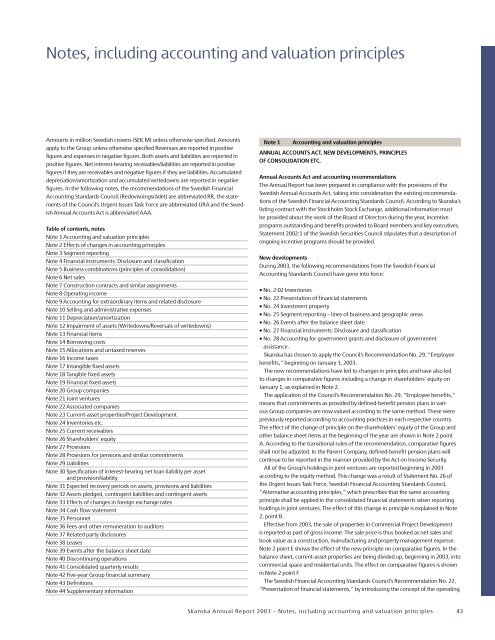Skanska Annual Report 2003
Skanska Annual Report 2003
Skanska Annual Report 2003
You also want an ePaper? Increase the reach of your titles
YUMPU automatically turns print PDFs into web optimized ePapers that Google loves.
Notes, including accounting and valuation principlesAmounts in million Swedish crowns (SEK M) unless otherwise specified. Amountsapply to the Group unless otherwise specified Revenues are reported in positivefigures and expenses in negative figures. Both assets and liabilities are reported inpositive figures. Net interest-bearing receivables/liabilities are reported in positivefigures if they are receivables and negative figures if they are liabilities. Accumulateddepreciation/amortization and accumulated writedowns are reported in negativefigures. In the following notes, the recommendations of the Swedish FinancialAccounting Standards Council (Redovisningsrådet) are abbreviated RR, the statementsof the Council’s Urgent Issues Task Force are abbreviated URA and the Swedish<strong>Annual</strong> Accounts Act is abbreviated AAA.Table of contents, notesNote 1 Accounting and valuation principlesNote 2 Effects of changes in accounting principlesNote 3 Segment reportingNote 4 Financial instruments: Disclosure and classificationNote 5 Business combinations (principles of consolidation)Note 6 Net salesNote 7 Construction contracts and similar assignmentsNote 8 Operating incomeNote 9 Accounting for extraordinary items and related disclosureNote 10 Selling and administrative expensesNote 11 Depreciation/amortizationNote 12 Impairment of assets (Writedowns/Reversals of writedowns)Note 13 Financial itemsNote 14 Borrowing costsNote 15 Allocations and untaxed reservesNote 16 Income taxesNote 17 Intangible fixed assetsNote 18 Tangible fixed assetsNote 19 Financial fixed assetsNote 20 Group companiesNote 21 Joint venturesNote 22 Associated companiesNote 23 Current-asset properties/Project DevelopmentNote 24 Inventories etc.Note 25 Current receivablesNote 26 Shareholders’ equityNote 27 ProvisionsNote 28 Provisions for pensions and similar commitmentsNote 29 LiabilitiesNote 30 Specification of interest-bearing net loan liability per assetand provision/liabilityNote 31 Expected recovery periods on assets, provisions and liabilitiesNote 32 Assets pledged, contingent liabilities and contingent assetsNote 33 Effects of changes in foreign exchange ratesNote 34 Cash flow statementNote 35 PersonnelNote 36 Fees and other remuneration to auditorsNote 37 Related party disclosuresNote 38 LeasesNote 39 Events after the balance sheet dateNote 40 Discontinuing operationsNote 41 Consolidated quarterly resultsNote 42 Five-year Group financial summaryNote 43 DefinitionsNote 44 Supplementary informationNote 1Accounting and valuation principlesANNUAL ACCOUNTS ACT, NEW DEVELOPMENTS, PRINCIPLESOF CONSOLIDATION ETC.<strong>Annual</strong> Accounts Act and accounting recommendationsThe <strong>Annual</strong> <strong>Report</strong> has been prepared in compliance with the provisions of theSwedish <strong>Annual</strong> Accounts Act, taking into consideration the existing recommendationsof the Swedish Financial Accounting Standards Council. According to <strong>Skanska</strong>’slisting contract with the Stockholm Stock Exchange, additional information mustbe provided about the work of the Board of Directors during the year, incentiveprograms outstanding and benefits provided to Board members and key executives.Statement 2002:1 of the Swedish Securities Council stipulates that a description ofongoing incentive programs should be provided.New developmentsDuring <strong>2003</strong>, the following recommendations from the Swedish FinancialAccounting Standards Council have gone into force:• No. 2:02 Inventories• No. 22 Presentation of financial statements• No. 24 Investment property• No. 25 Segment reporting – lines of business and geographic areas• No. 26 Events after the balance sheet date• No. 27 Financial instruments: Disclosure and classification• No. 28 Accounting for government grants and disclosure of governmentassistance.<strong>Skanska</strong> has chosen to apply the Council’s Recommendation No. 29, “Employeebenefits,” beginning on January 1, <strong>2003</strong>.The new recommendations have led to changes in principles and have also ledto changes in comparative figures including a change in shareholders’ equity onJanuary 1, as explained in Note 2.The application of the Council’s Recommendation No. 29, “Employee benefits,”means that commitments as provided by defined-benefit pension plans in variousGroup companies are now valued according to the same method. These werepreviously reported according to accounting practices in each respective country.The effect of the change of principle on the shareholders’ equity of the Group andother balance sheet items at the beginning of the year are shown in Note 2 pointA. According to the transitional rules of the recommendation, comparative figuresshall not be adjusted. In the Parent Company, defined-benefit pension plans willcontinue to be reported in the manner provided by the Act on Income Security.All of the Group’s holdings in joint ventures are reported beginning in <strong>2003</strong>according to the equity method. This change was a result of Statement No. 26 ofthe Urgent Issues Task Force, Swedish Financial Accounting Standards Council,“Alternative accounting principles,” which prescribes that the same accountingprinciple shall be applied in the consolidated financial statements when reportingholdings in joint ventures. The effect of this change in principle is explained in Note2, point B.Effective from <strong>2003</strong>, the sale of properties in Commercial Project Developmentis reported as part of gross income. The sale price is thus booked as net sales andbook value as a construction, manufacturing and property management expense.Note 2 point E shows the effect of the new principle on comparative figures. In thebalance sheet, current-asset properties are being divided up, beginning in <strong>2003</strong>, intocommercial space and residential units. The effect on comparative figures is shownin Note 2 point F.The Swedish Financial Accounting Standards Council’s Recommendation No. 22,“Presentation of financial statements,” by introducing the concept of the operating<strong>Skanska</strong> <strong>Annual</strong> <strong>Report</strong> <strong>2003</strong> – Notes, including accounting and valuation principles 43
















